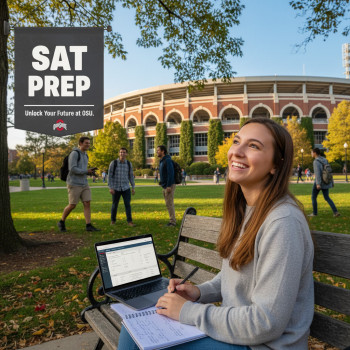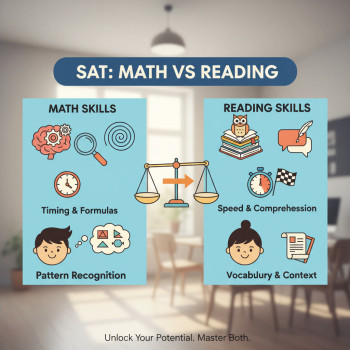Why this matters: the SAT, your application, and Indiana University Bloomington
If you’re reading this, you’re likely planning, worrying, or daydreaming about college—maybe all three at once. Indiana University Bloomington (IU) is a large, well-regarded public university with a broad range of majors, vibrant campus life, and a competitive applicant pool. For many students, the SAT is still an important piece of the admissions puzzle: it can reinforce your academic story, unlock scholarships, and give admissions officers another measure to pair with your GPA, activities, and essays.
This guide cuts through the clutter. You’ll find what IU typically looks for from SAT test-takers, how to interpret published score ranges, how test policies and deadlines fit into your timeline, and practical steps for preparing—along with study-plan examples and a realistic target-score table. I’ll also show where targeted support (like Sparkl’s 1-on-1 tutoring and tailored study plans) can make a real difference when you’re aiming for IU.

What IU typically expects from SAT scores
Universities usually publish ranges that represent the middle 50% of admitted students’ SAT totals—this gives you a practical target rather than a fixed cutoff. For IU Bloomington, the commonly reported middle 50% SAT range centers around the high 1100s to upper 1300s (on the 1600 scale). That means many admitted students score within that band, though there are always admitted students below and above it.
Two important takeaways:
- The middle 50% range is a useful benchmark for competitiveness, not an absolute rule—your application is reviewed holistically.
- Strong grades, challenging courses, compelling essays, and activities can offset a score that’s below the published range; conversely, a high SAT can strengthen an applicant whose transcript raises questions.
Is IU test-optional or test-required?
Admissions policies across the country have been changing over the past few years. IU’s stance is that SAT/ACT scores are considered in admissions and for many students they remain a recommended or required component—especially for certain scholarships or programs. Because policies can change year to year, treat test submissions strategically: if your score strengthens your overall profile or helps you access scholarship dollars, send it. If your score would clearly weaken your file relative to your GPA and coursework, you can weigh the option of not sending scores—after checking current IU policy for the exact admissions cycle you’re applying to.
Important dates and timeline for applicants
Planning backward from deadlines is the most practical way to make sure the SAT fits naturally into your application rhythm. Typical important dates for IU applicants include:
- Early Action deadline: early-November (commonly listed as November 1 for many applicants).
- Regular Decision deadline: early-February (commonly February 1).
- SAT test dates: multiple opportunities throughout the fall and spring—plan at least two sitting dates if you want to improve your score.
Practical timeline example (for a student applying Regular Decision on February 1):
- June–August (prior summer): set a target score, begin a structured prep plan.
- August–October: first official Digital SAT sitting (practice and assess).
- October–December: focused gap work, second sitting before application deadline if needed.
- January: final polish—essays, application forms, and optional final test if time allows.
How to set your SAT target for IU Bloomington
Setting a target score is both art and science. Use the published middle 50% as a starting point, then adjust for personal context—GPA, course rigor, letters of recommendation, and scholarship goals.
Sample target score tiers
Below is a table to help you translate ambition into numbers. These are practical benchmarks to guide your prep and application decisions.
| Competitiveness Tier | Target SAT Total (1600 scale) | What this means for IU |
|---|---|---|
| Safe | 1180–1250 | Within the lower half of the middle 50%—good fit for many programs and shows competency. |
| Competitive | 1260–1370 | Squarely inside the middle 50%—strong chance for admission and many scholarship considerations. |
| Stretch / Very Competitive | 1380–1500+ | Above the published range—improves chances for selective programs and merit awards. |
How to personalize your target
- If your GPA is a strength (e.g., very high or in rigorous AP/IB classes), you might set a slightly lower SAT target and focus on showcasing academic performance elsewhere.
- If you’re aiming for scholarships that list test thresholds, prioritize hitting those numbers even if they’re only modestly above the middle 50%.
- If you have lulls in your transcript (a weak sophomore year, for instance), a strong SAT can act as a reset button to demonstrate current academic readiness.
Strategies that actually move the needle
Preparation is not about hours logged so much as how you use them. Here are high-impact strategies parents and students can adopt right away.
1. Diagnose, then attack gaps
Start with a practice Digital SAT under realistic conditions. Identify the types of questions that take the most time or cause errors. Once you know your weaknesses—algebra fundamentals, command of evidence questions, grammar rules, or time pacing—build focused practice blocks around them. Random practice without diagnosis is busywork.
2. Make the Digital SAT format work for you
The SAT’s digital format changes pacing and navigation slightly. Practice on a device that mirrors test conditions, train yourself on digital tools (flagging questions, moving between passages), and simulate test-day stamina with full-length practice tests. Treat official practice resources as sacred: they’re the best signal of the real test.
3. Quality feedback beats quantity
Having someone to explain why an answer is wrong—and what the efficient path to the right answer looks like—accelerates learning. That’s where tailored tutoring helps: targeted, timely feedback prevents the same errors from repeating. If you’re exploring tutoring, look for 1-on-1 guidance, diagnostic-driven lesson plans, and measurable progress checks—features that Sparkl emphasizes in its personalized tutoring approach.
4. Use a cumulative calendar, not a to-do list
Block time for content review, mixed practice, timed sections, and full tests. Build in recovery days—brain breaks improve long-term retention. A weekly rhythm (e.g., two content days, one mixed-timing day, one full test every 2–3 weeks) is more sustainable than daily marathon sessions.
Practice plan example: 12-week ramp to the Digital SAT
This is a realistic blueprint if you have three months to prepare and want to improve meaningfully.
- Weeks 1–2: Diagnostic test + fundamentals. Focus on core algebra, grammar rules, and reading strategies.
- Weeks 3–6: Skills reinforcement. Alternating days for Math and Evidence/Reading, 45–60 minutes each session.
- Weeks 7–9: Timed practice sections and error analysis. Begin taking a full-length official practice test every other week.
- Weeks 10–12: Test simulation and polish. Full tests each week, review errors, and light content work focused on persistent weaknesses.
Tip: Keep an error log and revisit mistakes two weeks later—if the same types of errors reappear, that reveals gaps in practice quality, not effort.
How admissions officers at IU read your scores (and the rest of your file)
Admissions officers don’t just see a number—they see a student. They consider:
- Cumulative GPA and the rigor of your courses (AP, honors, IB, dual-enrollment).
- Trends—Did you improve over time? Have you challenged yourself recently?
- Essays and recommendations—do they reflect character, curiosity, and fit for IU’s community?
- Extracurricular depth—leadership and sustained involvement tend to carry weight.
If your SAT score is one of your stronger elements, it can amplify a narrative of readiness. If it’s weaker, make sure other parts of your application tell a compelling, consistent story.
SAT and scholarships at IU: what to know
Many universities award merit scholarships that factor in test scores. The higher your SAT (all else equal), the broader your options for merit-based awards. Even a 30–60 point improvement can be the difference between a small award and a significant scholarship package at a public research university.
Therefore, treating the SAT as a potential scholarship lever is smart financial planning. It’s worth preparing strategically if the cost of extra tutoring or prep is likely to pay for itself through scholarship awards.
Common applicant questions — answered plainly
Q: Do I need to send SAT scores?
A: Check IU’s current admissions policy for the cycle you’re applying to. If scores are optional, decide based on whether the score strengthens your file or unlocks scholarships. If in doubt, consult with a counselor or tutor who understands IU’s current practices.
Q: How many SAT sittings should I plan?
A: Two sittings is a good baseline: one to set a realistic baseline and another to show improvement. Some students benefit from a third attempt, but diminishing returns set in—focus on targeted practice between tests rather than simply taking more tests.
Q: What if my scores are below the range but my GPA is strong?
A: Emphasize your GPA, course rigor, and improvement trends. Use essays and recommendations to highlight academic curiosity and resilience. Consider optional supporting materials (like a teacher’s comments) that showcase your current capabilities.
Parent guide: how to support without micromanaging
Parents can be decisive allies in this process if they balance structure with trust. A few practical ways to help:
- Provide a calm testing environment at home the night before test days—rest matters more than last-minute cramming.
- Help set up a realistic calendar and celebrate small wins (a practice section completed is progress!).
- If finances allow, consider targeted tutoring for weak areas: 1-on-1 guidance, personalized study plans, and regular progress reports can give students clarity and momentum. Sparkl, for example, offers personalized tutoring with adaptive lessons and expert tutors that many families find helpful when the goal is a specific score improvement.
- Encourage balance—sleep, nutrition, and short breaks improve test performance and reduce stress.
Real-world examples: how students turned scores into decisions
Example 1: Sam, a student with a strong GPA (3.9) but an initial SAT of 1190, followed a 12-week targeted plan. By focusing on Algebra and pacing and using regular 1-on-1 sessions to correct persistent errors, Sam raised his score to 1320—moving from the lower to the competitive tier and becoming eligible for additional scholarship consideration.
Example 2: Priya, who had a 3.6 GPA and a practice SAT of 1400, used targeted test-taking strategies to regain confidence before applying to IU. Rather than chasing another incremental score gain, she invested time in polishing essays and seeking a supplemental recommendation; her final application communicated strong academic readiness and a compelling story about community impact.
Practice resources and what to use (and what to avoid)
- Use official practice tests that match the digital format—these give the most accurate simulation.
- Quality over quantity: 30 focused practice problems with deep review is better than 200 problems answered without analysis.
- Avoid random question banks that don’t explain the reasoning behind wrong answers—feedback is where progress happens.
Final checklist before you submit your IU application
- Confirm Ithaca application deadlines: Early Action and Regular Decision dates (don’t rely on memory—check the application portal).
- Decide whether to submit SAT scores based on comparison with IU’s middle 50% and any scholarship thresholds you’re targeting.
- Run a final audit: transcript, test scores (if submitting), essays, recommendations, and any arts or supplemental materials required by specific programs.
- If you used tutoring, ask for a final progress summary to include in your preparation notes—knowing your growth helps with interviews and essays.
Parting thoughts: keep perspective, aim deliberately
The SAT is an important tool, but it’s one of many. For applicants to Indiana University Bloomington, a thoughtful strategy—diagnose early, practice smart, and align your testing decisions with scholarship and program goals—pays off.
If you or your student feels uncertain about how to prioritize study time, consider a short consultation with a tutor who understands IU’s admissions landscape and the Digital SAT’s demands. Personalized tutoring—focused diagnostics, 1-on-1 guidance, and tailored study plans—can provide clarity and confidence when every application choice matters. Sparkl’s approach to individualized tutoring and AI-driven insights is designed to help students target weak spots quickly and show measurable improvement, which many families find especially useful in a high-stakes application season.
Above all: plan early, practice deliberately, and keep your application story cohesive. IU wants curious, prepared students—let your scores simply be one clear piece of that story.

Want help getting started?
Begin with a single diagnostic test, set one realistic target for the next test date, and build a 12-week plan around that goal. If you’d like guided, personalized support, consider connecting with a tutor who offers diagnostic analysis and a tailored study plan—you don’t need to go it alone.
Good luck—and remember: progress is steady, not sudden. One focused month of smart preparation often yields more than three months of unfocused effort. You’ve got this.















No Comments
Leave a comment Cancel